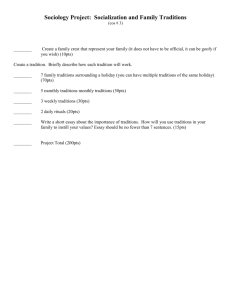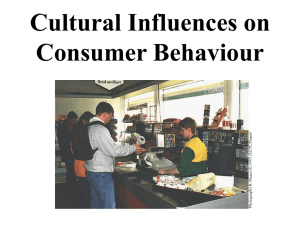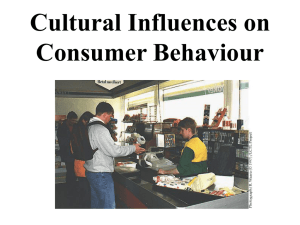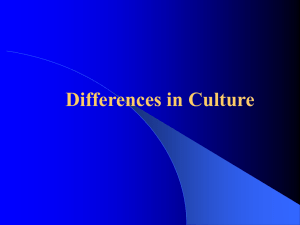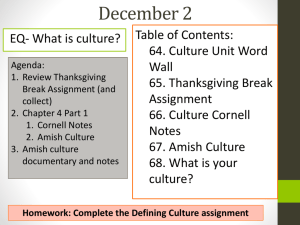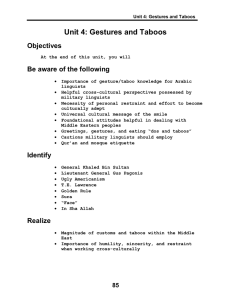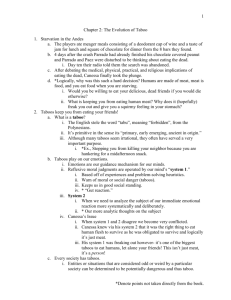Dimensions of Culture
advertisement
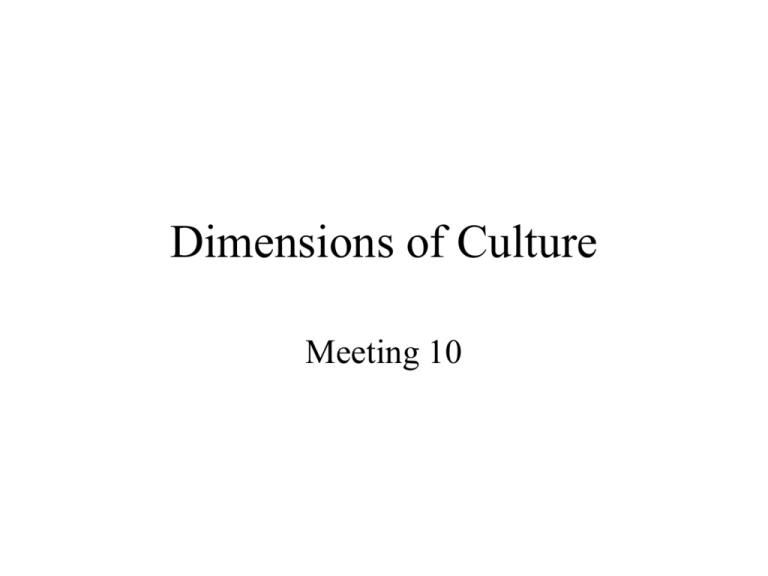
Dimensions of Culture Meeting 10 Culture Types • Mediated stories and images • Culture industry as economic resource • Business / corporate culture; may conflict with employee’s societal culture • Organizational culture - set of meanings • Groups w/ characteristic culture (religious) • Families with traditions Culture Transmission • Culture is patterns of meanings embodied in symbols • Primary symbol is language • Print capitalism created imagined communities • Transnational TV, Internet creating world language for business in English Protection Strategies for cultural products 1. Quotas - limit imports, preserve expressions of national identity 2. Subsidies and grants - government support for film and TV development 3. Regional alliances - co-produced films 4. Program adaptation - use formats and production values on local productions Resistance Measures • Recording own videos (Brazil) • Ownership of TV channels (Isreal) • Legislation to prohibit advertising in spliltrun editions with US (Canada) • Ban on direct broadcast satellite (China, India) Journalist’s Role • Empiricist concept of objectivity under attack for assuming a single truth • Enduring values built into news judgment; values and opinions enter unconsciously • News culture is revealed in formats: voiceovers, outtakes, sound bites, stand-ups Cultural Conflict • Many groups feel they are buried by global culture and corporations • Kurds have no nation-state • Med-TV establish as voice of Kurdish people in all countries • Discontinued for arousing anger • Cultures struggle to preserve a distinctive identity Hybrid Culture and Media • Melting pot concept - give up some cultural distinction for democratic rights • Hybridity occurs when traditions are modified • Cultural identity is fluid and dynamic • Histories change and develop as they blend • Dominant culture takes on traditions of migrants • Media fusion in all forms directed a culturespecific audiences Culture Onion • Symbols - words, pictures, gestures, objects that are learned; global brands • Heroes - possess prized characteristics; serve as role models for behavior • Rituals - essential collective activities • Values - broad tendencies to prefer certain state of affairs over another Cultural Nuances Selective perception - focus on certain features of environment excluding others What does it mean to perceive things according to our cultural map? Stereotyping - put people into categories Why is necessary for advertising to stereotype? Thinking patterns, Intellectual styles • Linear, external logic, intuition, duality & digital thinking is Western What are bipolar scales? • Pattern recognition, synchronicity and analog are Eastern • Intellectual styles: Gallic, Teutonic, Saxonic, Nipponic • Learning as critical thinking or memorizing Body Language • Facial expressions • Behavioral habits • Gestures: greetings, beckoning, insulting, touching • Use of space and closeness between people • Visual point of view • Music and rhythm Color • Relativist - local situation has large impact • Universalist - ignore taboos, go with trends Rules: Choose national colors; blue for Northern hemisphere, green for southern Color Taboos White - funerals in China, red for brides Black - mourning, widow wear in Europe, aggression for teens Orange - trendy, extreme sports, boats, highway workers Yellow - bottom of preference list (yellow journalism, yellow Jewish star, cowardly) Silver - space-age, high tech, neutral, elegance; most popular auto color Purple - Royalty Cultural Context High-context - information part of internalized message; implicit. Symbolic advertising. Eastern Low-context - explicit verbal message. Yes/no orientation. Western. Mixed - France has blend of hi-lo institutions and situations Dimensions of Time Includes biological, personal, metaphysical, micro, sync, sacred, profane • Long vs short term thinking • Time as healer • Orientation toward past (Europe), present (East where all are equal), future (disposable in US) • Linear vs Circular • Monochronic (low context) vs polychronic • Cause & effect vs holistic • Time as symbol (cue up = M time) Relationship to Nature 1. Mastery over nature - man must conquer (US) 2. Harmony with nature - man co-exists with; no distinction between human life, nature and supernatural (Japan) 3. Subjugation to nature -man dominated by (Africa) Hofstede’s 5 Dimensions 1. Power Distance - social hierarchy vs. equality 2. Individualism (private & public) / collectivism (particularistic, common good) 3. Masculinity (achievement values) /femininity (caring values) Hofstede 4. Uncertainty avoidance - feel threatened by ambiguity; conflict and competition are threatening. • Strong UA countries use hands, drive fast 5. Long-Term - persistence, ordering by status, thrift, sense of shame. Vs. Short-term orientation - personal steadiness, protecting face, tradition, reciprocation of gifts Cultural Identity in Slovenia • Distancing selves from ‘Balkans’ of violence and chaos, poverty, dirt • Young cannot identify with parents communism or Yugo-nostalgia • 1980s - art and rock bands pop icons • 2002 - youth apolitical, consumer-oriented • Globalized culture is pro-West everything



